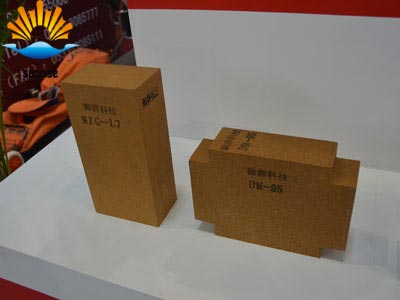Hot Product
Refractory Knowledge
Performance introduction and application range of Sunrise Refractory magnesia brick for sales
Date:2019-05-30 17:15 From:Zhengzhou Sunrise Refractory Author:admin
Magnesia bricks have a refractoriness of more than 2000, and the load softening temperature varies greatly depending on the melting point of the cemented phase and the amount of liquid phase produced at high temperatures. Generally, the load-softening start temperature of magnesia bricks is between 1520 and 1600, while that of high purity magnesia bricks is up to 1800. The loading softening start temperature of the magnesia brick is not much different from the collapse temperature. The linear expansion rate of magnesia bricks from 1000 to 1600 is generally 1.0% to 2.0%, and is approximately linear. In refractory products, the thermal conductivity of magnesia bricks is second only to that of carbon-containing bricks, which decreases with increasing temperature. Under 1100 and water cooled conditions, the thermal shock resistance of magnesia bricks is only 1 or 2 times. Magnesia bricks are resistant to corrosion by alkaline slags such as iron oxide and calcium oxide, but are not resistant to attack by acid slag containing silicon oxide. Therefore, they cannot be directly contacted with silica bricks when used, and are generally separated by neutral bricks. The conductivity of magnesia bricks at normal temperature is very low, but when it is high temperature, such as 1500 can not be ignored, it should be paid attention to when it is used in the bottom of electric furnace, especially when it is wet.
 The microstructure of magnesia bricks is actually a combination of magnesia microstructures. The microstructure of the magnesia brick made of a magnesia is the simplest, except that the matrix part is loose and the pores are more. Magnesia bricks made of different grades of magnesia have obvious differences in their microstructure. Magnesia bricks made of magnesia with high impurity content have many silicate phases, and the MgO crystals are round and the direct bonding rate is low. The content of impurities in raw materials is small, and the magnesia bricks with ultra-high temperature firing are reduced, the silicate is reduced, and the direct bonding rate is high. In the magnesia bricks with the MgO content of 98% or more, the MgO crystals are self-shaped and semi-automorphic. True intergranular direct bonding is only possible in materials that do not contain silicates and intercrystalline pores.
The microstructure of magnesia bricks is actually a combination of magnesia microstructures. The microstructure of the magnesia brick made of a magnesia is the simplest, except that the matrix part is loose and the pores are more. Magnesia bricks made of different grades of magnesia have obvious differences in their microstructure. Magnesia bricks made of magnesia with high impurity content have many silicate phases, and the MgO crystals are round and the direct bonding rate is low. The content of impurities in raw materials is small, and the magnesia bricks with ultra-high temperature firing are reduced, the silicate is reduced, and the direct bonding rate is high. In the magnesia bricks with the MgO content of 98% or more, the MgO crystals are self-shaped and semi-automorphic. True intergranular direct bonding is only possible in materials that do not contain silicates and intercrystalline pores.
The performance of magnesia bricks varies greatly depending on the raw materials, production equipment and process measures.
Because of its high temperature performance and strong resistance to metallurgical slag, magnesium brick is widely used in steel industry lining, iron alloy furnace, mixed iron furnace, colored industrial furnace, copper, lead, tin, zinc lining building industry lime burning kiln; glass Industrial regenerator grids and civil heat exchangers; high temperature calcining kiln for refractory industry, such as high temperature shaft kiln for calcining magnesia, high temperature tunnel kiln for burning alkaline refractory bricks, etc.

The performance of magnesia bricks varies greatly depending on the raw materials, production equipment and process measures.
Because of its high temperature performance and strong resistance to metallurgical slag, magnesium brick is widely used in steel industry lining, iron alloy furnace, mixed iron furnace, colored industrial furnace, copper, lead, tin, zinc lining building industry lime burning kiln; glass Industrial regenerator grids and civil heat exchangers; high temperature calcining kiln for refractory industry, such as high temperature shaft kiln for calcining magnesia, high temperature tunnel kiln for burning alkaline refractory bricks, etc.
Inquiry:
If you have any questions or good suggestions on our products and site, or if you want to know more information about our products, please write them and send to us, a representative will contact you within one business day. We guarantee that your information will not be divulged to the third party.

